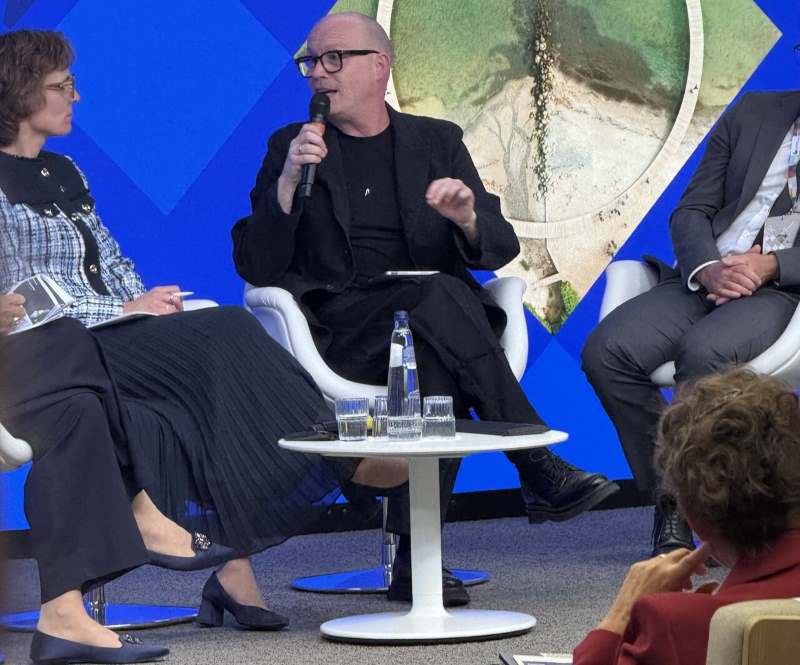Boutique Living, a leading home textiles and linens brand, has introduced the Caressa Collection, a luxurious blend of TENCEL™ branded fibers and cotton. The collection is designed to enhance sleep quality with unmatched levels of softness, comfort, and a range of positive wellness effects.
TENCEL™ fibers are extracted from the eucalyptus tree and are known for their natural goodness, including their ability to regulate temperature and moisture, promote healthy skin, and resist bacteria. When blended with cotton, TENCEL™ fibers create bed linens that are softer, more durable, and more breathable than traditional cotton linens.
The Caressa Collection features a diverse range of understated designs inspired by global design sensibilities and the timeless charm of American homes. The bed sheet sets offer a classic, enduring look that transcends trends, and the Dohars embody superior softness and style.
Impacted by Global Factors and Policy Intervention
RMG export from Bangladesh declined by 13.93% in October 2023, from 3.68 billion dollars in October 2022 to 3.17 billion dollars in October 2023. This decline is attributed to a number of factors, including:
Global economic downturn caused by historic high inflation and the Russia-Ukraine war
Labor unrest in Bangladesh in the final week of October
Rising cost of inputs, including fuel, gas, electricity, and transportation
Increase in minimum wages for garment workers
Despite the decline in October, RMG export from Bangladesh for the period of July-October 2023 still showed a 5.59% year-over-year growth. However, overall export earnings for July-October 2023 grew by only 3.52%, falling 9.31% short of the strategic export target for the same period.
Overall, the decline in RMG export in October is a reminder of the challenges that the industry is facing. It is important for the government and the industry to work together to address these challenges and to ensure that the RMG sector remains a competitive driver of economic growth in Bangladesh.
Import Export Show to Explore UK's Post-Brexit Status in Global Trade
Brexit has transformed the UK's trade landscape in many ways, and one key question is how it has affected the country's global trade reputation. Some supporters of Brexit hoped that the UK would gain more autonomy and influence in global trade affairs, but opponents contend that the UK has actually weakened its position and bargaining power outside the EU.
The upcoming Import Export Show, a prominent event in the UK trade sector, will explore this topic in depth. Two of the speakers at the event have shared their views on the UK's current role in global trade.
Overall:
It is clear that Brexit has had a significant impact on the UK's global trade reputation. The full extent of this impact is still being debated, but it is clear that the UK will need to work hard to rebuild its reputation as a trusted and reliable trading partner.
Speakers at the 15th Bangladesh Denim Expo emphasized the need to double denim exports to achieve the country's ambitious US$100 billion apparel export target by 2030.
Commerce Minister Tipu Munshi highlighted Bangladesh's strong position as the world's second-largest apparel exporter and its dominance in denim exports to the EU and USA, surpassing even China. He attributed this success, in part, to the Bangladesh Denim Expo's contributions.
Siddiqur Rahman, former president of BGMEA, underscored the significance of denim and denim-related products, accounting for about one-fourth of Bangladesh's total apparel exports. He expressed confidence in doubling denim exports by 2030, citing the country's advancements in workplace safety and sustainability, making it an attractive apparel sourcing destination.
Faruque Hassan, BGMEA president, emphasized Bangladesh's commitment to sustainability, with 200 green garment factories LEED certified by the United States Green Building Council (USGBC). He added that eight of the world's top 10 green factories are now located in Bangladesh.
The 15th Bangladesh Denim Expo, held in Dhaka, brought together industry leaders, manufacturers, and buyers to discuss the latest trends and innovations in the denim sector. The event showcased Bangladesh's capabilities and reaffirmed its position as a global denim manufacturing hub.
Currency-neutral revenue increased by 1%, driven by growth in all regions except North America.
Top-line growth reflects a focus on conservative inventory management and full-price sales.
Gross margin improved by 0.2 percentage points to 49.3%, driven by lower freight costs, a more favorable business mix, and lower inventory allowances. Discounting levels continue to improve.
Operating profit of €409 million includes extraordinary expenses of around €110 million.
Conservative sell-in strategy is paying off as inventory position improves substantially compared to the second quarter to €4.8 billion, down 23% year-over-year.
Overall, the company's results demonstrate the success of its focus on conservative inventory management, full-price sales, and cost reduction initiatives.
Marzoli, a leading provider of spinning solutions, has unveiled its innovative Roving Frame FTM320, demonstrating its commitment to advancing textile manufacturing. This revolutionary machine boasts a central headstock and independent double-side modules that operate simultaneously, maximizing efficiency and reducing downtime.
The single Marzoli Revolver Exchanger for both sides, coupled with an optimized train layout in the creel, enhances transport efficiency and simplifies maintenance. Additionally, a single OHTC (Oil Heating Tank) for both sides minimizes cleaning and maintenance costs.
Marzoli further enhances automation with its Integrated Transport System, streamlining yarn transportation and further streamlining operations. To further enhance yarn quality, Marzoli has developed the IBC (Integrated Bobbin Cleaner), a simple yet effective device that efficiently removes residual roving from ring frame tubes.
These groundbreaking achievements demonstrate Marzoli's dedication to providing the industry with cutting-edge technologies that elevate spinning efficiency, reliability, and sustainability. The Roving Frame FTM320, Integrated Transport System, and IBC represent a significant leap forward in textile manufacturing, setting new standards for yarn production.
As per Seshadri Ramkumar, Professor, Texas Tech University, USA recent report, A decline in global textile demand is rippling through the cotton ecosystem, impacting production, prices, and mill operations. India, the second-largest cotton producer, is projected to see a lower output in the upcoming season, while spinning margins have dwindled despite reduced cotton prices.
Factors contributing to the demand slump include trade imbalances, high power costs in India, and reduced global demand. This has led to unit closures in South India and reduced yarn consumption.
Industry experts emphasize the need to closely monitor global economic trends, demand patterns, and supply dynamics before making expansion or inventory decisions. They hope that a revival of global demand, particularly during the Christmas season, will provide a much-needed boost to the textile industry.
Karl Mayer, the industry leader in textile machinery, introduces an innovative TEXTRONIC Lace machine that promises to redefine lace production. The MT 84/1/40 S, set to be officially unveiled in November 2023, showcases an exceptional blend of traditional craftsmanship and modern technology.
This cutting-edge lace machine creates delicate lace articles with a captivating, contrasting fabric appearance. The key highlight is its remarkable resemblance to 12-point Leavers lace quality, a feat acknowledged by Karl Mayer's lace expert, Jamie Heather.
The MT 84/1/40 S employs a pioneering configuration, incorporating a stitch-forming Jacquard bar and two ground guide bars. This unique setup enables the production of high-contrast lace with multi-layered patterns and even allows for the creation of lighter fabric grounds without the need for pillar stitches. The addition of a fall-plate and an increased number of pattern bars further enhances the intricacy of the lace produced.
Karl Mayer plans to showcase this groundbreaking lace machine at a product show in Changzhou City, China, parallel to ITMA ASIA, where industry enthusiasts can witness the MT 84/1/40 S in action, signaling a new era in lace manufacturing.
Bowker Asia Limited, a leading sportswear specialist, has reported significant improvements in its operational efficiency and performance following the adoption of Coats Digital's FastReactPlan. The key news angle here is the impressive impact this software has had on Bowker's operations, including a 10% increase in capacity plan accuracy, a 3% boost in production efficiencies, and a remarkable 10% improvement in on-time delivery performance (OTDP).
Before implementing FastReactPlan, Bowker relied on manual processes, which were time-consuming and often led to inaccuracies and inefficiencies in their production and scheduling. With this new software, the company has achieved a unified, real-time source of information, allowing them to assess and manage production capacity, collaborate across departments, and make informed decisions quickly. This has also reduced the duration of management meetings by 50%.
Furthermore, Bowker can now view capacity plans from multiple angles, enhancing their understanding of production capabilities and limitations. The software enables them to effectively balance capacity in various scenarios, ultimately leading to a 10% improvement in OTDP.
Bowker's success with FastReactPlan has not only boosted operational efficiency but also freed up valuable time for staff to focus on innovation and business growth. Coats Digital, the provider of FastReactPlan, recognizes the transformative impact of this software and is enthusiastic about its partnership with Bowker to continue driving efficiency and innovation in the sportswear manufacturing industry.
This story highlights how technology solutions like FastReactPlan can significantly improve efficiency and performance in the fashion apparel manufacturing industry, with Bowker Asia Limited serving as a successful example.

The fashion industry is being pushed fast and hard towards circularity and the EU is perhaps its most vocal implementer, having introduced key legislations that regulate the environmental and social impact of fashion. Hong Kong-based environmental NGO Redress that specializes in sustainability in Asia, released an industry report related to Asia’s manufacturing bases for the global fashion sector. The report clearly highlights Asian supply chains are nowhere near ready to deliver the need of the future and this worrisome as Asia is the global manufacturing hub for textiles and apparel.
As Christina Dean, Founder, Redress, supported by the VF Foundation points out, the three main gaps are: design knowledge, financial challenges in an extremely price-sensitive sector and leadership skills to steer Asia towards fashion circularity in a meaningful way. The report was presented at a panel discussion at Fashion Summit Hong Kong, Asia's sustainable fashion event, as well as at Shanghai Fashion Week.
Design knowledge gap hinders transition
It’s the time for a now or never approach in Asia, where organizations that support fashion circularity and expert and experienced designers collaborate to conceptualize and implement circularity best practices to ensure Asian hubs are able to fulfill the circularity model that is the future of fashion. Redress’ study comprised 195 global fashion professionals, the methodology being mainly in the form of quantitative questionnaires supported by 40 qualitative interviews with professionals working with organizations that produce apparels for Europe, China and South East Asia.
Almost 79 per cent respondents acknowledged the current design knowledge gap that is going to be a significant obstacle for circularity to be implemented. The two main factors to bridge the gap were identified as: education and capacity building. It is going to be vital for Asia’s manufacturing hubs to understand that the first step towards achieving circularity is based on product design that sources sustainably, builds in longevity and factors in recyclability. Capacity building includes turning manufacturing plants to widen their scope to suit the manufacturing of sustainable and recyclable items.
Financial challenges
Apart from the existing design knowledge gap, financial barriers are yet another challenge that the Asian fashion sector requires to iron out. Having positioned itself as the most affordable region for sourcing, most manufacturing hubs operate on compromised margins that leave little room for investing in transitioning to sustainable and circular fashion’s supply chain. In this context, the senior managements of manufacturing companies have not shown much enthusiasm to plough back funds towards building capacity as well as the restructuring of the linear model into a circular one. One may also add that Western buyers have a large role to play because they might espouse the need for fashion to be circular but are not willing to undergo a price recalibration that comes with an entire manufacturing sector realigning itself. For both parties, the vendor and the buyer, the mind-set is short-term gain focused rather than looking ahead to deliver on sustainable fashion in tangible ways.
The transition could be a rocky
Analyzing the report begets the question how can Asia, the region that produces nearly 60 per cent of apparel for worldwide consumption, not deliver to the growingly stringent regulations bring imposed on the global fashion sector? How will it affect the worldwide trade? These are important questions that Western markets are looking at. The cost-efficiency of Asian manufacturing hubs have been the biggest attraction but as expected, may not be sustainable as positive environmental and social impact will draw up a heftier price tag. The moot point is will investors be ready to take the plunge to transition or withhold knowing any shift in pricing could bring about seismic changes amongst Western buyers.
More...
- 1
- 2
- 3
- 4
- 5
- 6
- 7
- 8
- 9
- 10
Europe’s Circular Turn: The Danish vision shaping a new industrial era
In a speech that captured both urgency and ambition, Danish MEP Rasmus Nordqvist stood before an audience of European policymakers,... Read more
“The US government’s economic data makes no sense. It’s a con.” says David Birnb…
“The US government’s economic data makes no sense. It’s a con,” declares David Birnbaum, strategic planner for the global garment... Read more
India's fiber sector spins a new thread of growth
India's clothing fiber sector is on the cusp of a revolutionary decade, moving beyond its traditional identity as a cotton... Read more
Global Supply Chain Earthquake: The 100% ‘Trump Tariff’ and the scramble for Chi…
The imposition of an additional 100% tariff on all Chinese goods by President Donald Trump—a move that underscores the fickleness... Read more
Trump's 100% Tariff on China: Why should Indian apparel exporters not view this …
The announcement by President Donald Trump to impose an additional 100% tariff on all Chinese goods, on top of existing... Read more
Yarn Expo Autumn 2025: A premier international platform for the yarn industry
Yarn Expo Autumn 2025 concluded a highly successful run, firmly establishing its position as the premier international platform for the... Read more
The Fashion Week of the Decade In Paris: A new chapter for the industry
The highly anticipated fashion week season, which came to a close recently in Paris, was not "business as usual". The... Read more
Tariffs Are Killing "Free, Open" Trade,The Human Cost of Uncertainty: …
In the intricate, interconnected world of global apparel, tariffs are not just a line item on an invoice—they are, in... Read more
China's apparel industry battles a mid-2025 contraction
The summer of 2025 brought an abrupt end to the modest recovery that China’s apparel industry experienced in the previous... Read more
Class: BlockTexx puts Australian innovation on the global sustainability map
In a landmark development for the Australian recycling sector, BlockTexx, a pioneer in textile waste recovery, has become the first... Read more












